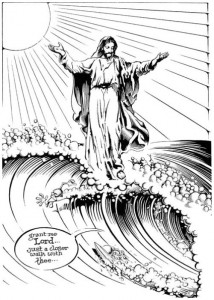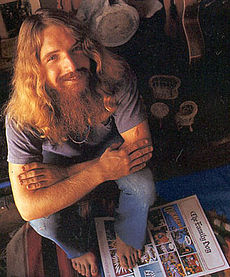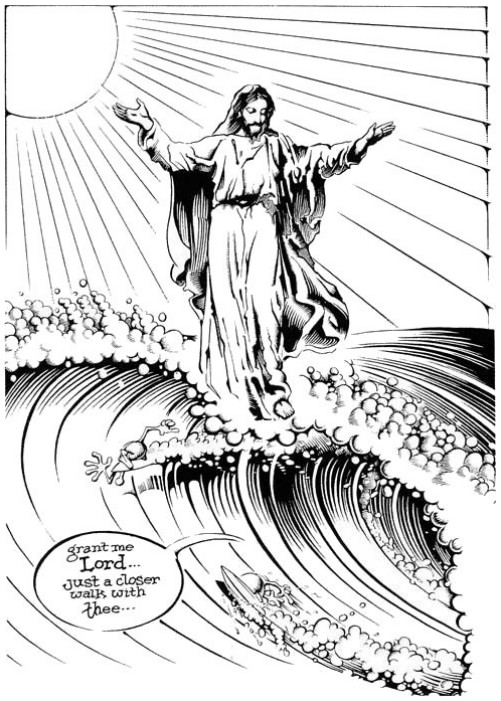 Several weeks ago when I was researching for my video on the “Gospel According to Comedians,” I came across the graphic on the cover of today’s bulletin. At the time I thought this graphic would prove useful or provocative to me, but I wasn’t sure for what purpose, so I kept the file on my screen’s desktop. Ever since then the thumbnail image of Jesus surfing the waves hung there on my desktop, begging me to go back to it, to find out more about who created the image and for what reason.
Several weeks ago when I was researching for my video on the “Gospel According to Comedians,” I came across the graphic on the cover of today’s bulletin. At the time I thought this graphic would prove useful or provocative to me, but I wasn’t sure for what purpose, so I kept the file on my screen’s desktop. Ever since then the thumbnail image of Jesus surfing the waves hung there on my desktop, begging me to go back to it, to find out more about who created the image and for what reason.
Not surprisingly, the image was created by someone deeply involved with surfer culture, the surfer and artist Rick Griffin. Even though I am originally from Southern California, I don’t know the first thing about surfing. When I first dove into the task of researching the image, I thought I would spend some time learning about surfing culture and the lingo. As it turns out, the surfing culture is deep and wide, and surfers have a language and a code of ethics unique to them. One thing central to proper surfing etiquette is to not act out or talk about your surfing ability beyond your actual ability. Surfers have a word for self-promoters like this: kooks. For example, you are a kook if “you finish your ride on top of a toddler’s sand castle halfway up the beach” or “you’ve had a board for eighteen months, and it’s never seen surf wax.”
 When I was an adolescent movies like Cameron Crowe’s 1982 Fast Times at Ridgemont High created a stereotype of teenage surfer dudes from “So Cal” in Sean Penn’s character, Spicoli, a burnout with no comprehension of future responsibility as an adult. If you know this movie, you probably already have Sean Penn’s face and his long, wavy, unwieldy surfer hair in your imagination. It was this kind of face and hair that I came across when I found some images of the artist Rick Griffin. And so, I quickly judged him by his looks: typical burnout surfer dude. There is probably some element of this surfer stereotype at work in Rick’s story, but as I found out there is way so much more.
When I was an adolescent movies like Cameron Crowe’s 1982 Fast Times at Ridgemont High created a stereotype of teenage surfer dudes from “So Cal” in Sean Penn’s character, Spicoli, a burnout with no comprehension of future responsibility as an adult. If you know this movie, you probably already have Sean Penn’s face and his long, wavy, unwieldy surfer hair in your imagination. It was this kind of face and hair that I came across when I found some images of the artist Rick Griffin. And so, I quickly judged him by his looks: typical burnout surfer dude. There is probably some element of this surfer stereotype at work in Rick’s story, but as I found out there is way so much more.
 Rick was born in June 1944 in Palos Verdes, California and grew up in that area of So Cal and quickly became identified as a talented illustrator. At the age of 19 he had hitched a ride to San Francisco, preparing to catch a freighter to Australia. Rick had fallen asleep in the car, and when he woke up he found the driver laughing and the car careening out of control. The horrible car accident almost killed him, and he wound up in a morphine-induced coma. While in his coma he saw fantastic apocalyptic visions that fed his artistic imagination his whole life. Injuries scarred his face for life, which is why he grew his hair long and kept a beard.
Rick was born in June 1944 in Palos Verdes, California and grew up in that area of So Cal and quickly became identified as a talented illustrator. At the age of 19 he had hitched a ride to San Francisco, preparing to catch a freighter to Australia. Rick had fallen asleep in the car, and when he woke up he found the driver laughing and the car careening out of control. The horrible car accident almost killed him, and he wound up in a morphine-induced coma. While in his coma he saw fantastic apocalyptic visions that fed his artistic imagination his whole life. Injuries scarred his face for life, which is why he grew his hair long and kept a beard.
After he recovered, he made his way to San Francisco where he connected with the hippy scene, one thing led to another, and soon he was creating some of the most iconic artwork for the 1960s alternative music subculture. He designed album covers and posters for the most famous musicians of the day: the Doors, Jimi Hendrix, The Grateful Dead, The Who, Janis Joplin, and even some work for The Beatles.
 In the early 1970s through friends in the Jesus People, Rick went through some kind of Christian conversion and eventually hooked up with Chuck Smith of the rapidly-growing Calvary Chapel in Costa Mesa. Rick illustrated a booklet on the Gospel of John as an evangelistic tool, written by pastor Chuck Smith. Rick then became Art Director of Marantha! Music and produced original artwork for the newly developing Christian music industry.
In the early 1970s through friends in the Jesus People, Rick went through some kind of Christian conversion and eventually hooked up with Chuck Smith of the rapidly-growing Calvary Chapel in Costa Mesa. Rick illustrated a booklet on the Gospel of John as an evangelistic tool, written by pastor Chuck Smith. Rick then became Art Director of Marantha! Music and produced original artwork for the newly developing Christian music industry.
Rick lived a complicated life and battled off and on with addiction to drugs, even well after he became a Christian. Some say his faith ebbed and flowed with his addictions. Life as an artist is a tough life, even when you’re acknowledged as one of the icons of a movement, such as Rick was within the uniquely American psychedelic art movement of the 1960s. It was a beautiful day August 15 of 1991 when Rick had just learned from his agent that one of his artworks sold at a gallery for $1800; he really needed the money. He got on his Harley to drive into San Francisco to meet the art dealer. On the highway on his way to the gallery he was passing a van when the van changed lanes and broadsided Rick. Just as had happened to him at age 19, Rick wound up in a coma for three days, except this time he didn’t make it out of the coma. Rick Griffin died August 18, 1991 at the age of 47. He would have turned 70 June 18 of this year.
Before I stumbled across this image of Jesus surfing I didn’t know anything about Rick Griffin or that he even existed, but I surely had seen his artwork here and there. I spent several hours reading about his life and examining his artwork because when I first read the basic facts of his life, I felt a kinship to him: my parents were born just one year before Rick; our families are from So Cal; and I, too, have a similar story of conversion. I think back to that August of 1991 when Rick Griffin died in that motorcycle accident. I was in my second month of being “born again” at the age of 23. I found new life in Christ. Rick’s complicated life ended in tragedy.
Look at Rick Griffin’s image of Christ on the waves again. If I ask you, “Is this image true?” how would you answer?
Whether or not artwork is “true,” “yes” or “no,” doesn’t make any sense. Maybe artwork reveals truth, but that seems to miss the point of artwork. People create art to express themselves, to show something with a fresh perspective, to juxtapose non-traditional elements to create new meaning, to inspire and give life to people, to give reality to imagination.
Consider the John passage we heard this morning:
14 5Thomas [the doubter] said to him, “Lord, we do not know where you are going. How can we know the way?” 6Jesus said to him, “I am the way, and the truth, and the life. No one comes to the Father except through me. 7If you know me, you will know my Father also. From now on you do know him and have seen him.”
Jesus talked about going to his “Father’s house [where] there are many dwelling places [to] prepare a place for you.” Thomas asked for directions of how to get there. Jesus answered, “I am the directions!” In other words, Thomas wanted to know how to get to the grand art gallery to see the greatest works of art that have ever been made, and Jesus answered, “I am the way to the master artist himself! Follow me alone to see the master artist in person. In fact, through me you have already seen the master artist!”
Whether or not artwork is “true,” “yes” or “no,” doesn’t make any sense. Maybe artwork reveals truth, but that seems to miss the point of artwork.
Sometimes the disciples acted like kooks. They just didn’t get it. They sought after things and accomplishments that were beyond their current ability or understanding. But Jesus set forth a way for the disciples to follow, to do even greater things! And yet the disciples were still so interested in some kind of end product or final revelation of the “Father” as the great Oz behind the curtain.
This is the whole point of John’s Gospel, to clearly portray Jesus as the Christ, as the Messiah, as the One and Only God in the flesh. Some scholars even go so far as to say that verse six of chapter fourteen is the apex of the Gospel of John’s teaching: “I am the way, and the truth, and the life. No one comes to the Father except through me.” The ultimate point of John’s Gospel is that Jesus Christ is the way, the way that brings truth and life to the followers of his way. “Truth” and “life” describe the way. No one can follow this particular way by following anyone or anything else than Jesus. This is about the incarnation of God in Jesus the Christ. I don’t think the statement is about the inability of other world religions to generate encounter with the divine source of the cosmos. And I don’t think Jesus’s claim is about the capital “T” truth of Christianity over against all other world religions; that would be to pour into his words two thousand years of Christian history as a world religion and our contemporary experience with globalism and pluralism. Now, certainly, this is how this passage is often interpreted and used to degrade the “truth” of other religions and/or to elevate the truth claims of Christ and Christianity. That is a reasonable interpretation, but I think it has more roots in modern philosophy and the issues of post-colonialism than it does in the historical context of the passage itself, let alone its immediate figures of speech and grammar.
The ultimate point of John’s Gospel is that Jesus Christ is the way, the way that brings truth and life to the followers of his way. “Truth” and “life” describe the way. No one can follow this particular way by following anyone or anything else than Jesus.
One thing that stands out to me is the ironic usage of the text: “grant me Lord … just a closer walk with thee.” There is a well-known hymn based on these words, which are an allusion to Paul’s words in 2 Corinthians 5:7: “for we walk by faith, not by sight.” The context of Paul’s “walk by faith, not by sight” remark is the afterlife and the centrality of “being with the Lord” compared to the false importance of knowing what the afterlife will be like. A few verses later Paul says, “For the love of Christ urges us on, because we are convinced that one has died for all; therefore all have died. And he died for all, so that those who live might live no longer for themselves, but for him who died and was raised for them. … So if anyone is in Christ, there is a new creation: everything old has passed away; see, everything has become new!”
Another thing that stands out to me is the sheer fact that Rick Griffin placed Jesus in his own context … surfing … and without a surfboard! Stephen did the same thing in the Acts 7 passage we heard. Stephen placed Jesus squarely in the history of Israel, as Israel’s Messiah, and then he took away the surfboard, the centrality of the Temple by re-interpreting Isaiah 66:
“Yet the Most High does not dwell in houses made with human hands; as the prophet says,
‘Heaven is my throne,
and the earth is my footstool.
What kind of house will you build for me, says the Lord,
or what is the place of my rest?
Did not my hand make all these things?’”
The implication is clear in Stephen’s speech: it’s one thing to worship in the Temple, but if you don’t listen to the Holy Spirit through the prophets like Moses, Isaiah, Stephen, and God’s ultimate messenger, Jesus Christ, then, in surfer lingo, you’re in the gnarly surf heading for the rocks, regardless of how stoked you are and how rad your board is. Of course the people did not like being called out as kooks for their false commitments. Just before they ganged up on Stephen …
7 … 55he gazed into heaven and saw the glory of God and Jesus standing at the right hand of God. 56“‘Look,” he said, “I see the heavens opened and the Son of Man standing at the right hand of God!” 57But they covered their ears, and with a loud shout all rushed together against him. 58Then they dragged him out of the city and began to stone him; … 59While they were stoning Stephen, he prayed, “Lord Jesus, receive my spirit.” 60Then he knelt down and cried out in a loud voice, “Lord, do not hold this sin against them.” When he had said this, he died.
Stephen followed in the way of Jesus. He proclaimed the gospel message and challenged his hearers to give up false idols, and then as he was being killed for his witness, in his dying act he truly followed the way of Jesus by asking God to forgive his killers.
According to one account, “Rick Griffin’s last published work was printed in the San Francisco magazine, The City, shortly before his death; a self-portrait of a man at Heaven’s Gate, pen and ink in hand.”
Yesterday a group of us here at PUMC were asked a question by Rev. John Bell of Wesley UMC in Aurora, “At the end of the day what kind of person do you want to be?” People remember Stephen for his speech and his martyrdom. People remember Rick Griffin for his expressive and prodigious artwork. Surely they both had shortcomings and struggles, but they did their best to express and share their faith with the talents God gave them.
What kind of person do you want to be? How do you and will you follow Jesus as the way?
(Note to the reader: I pieced together the relevant facts of Rick Griffin’s life into a narrative as best as I could from several websites. Please accept my apology if I have misrepresented him or got the facts mixed up.)



